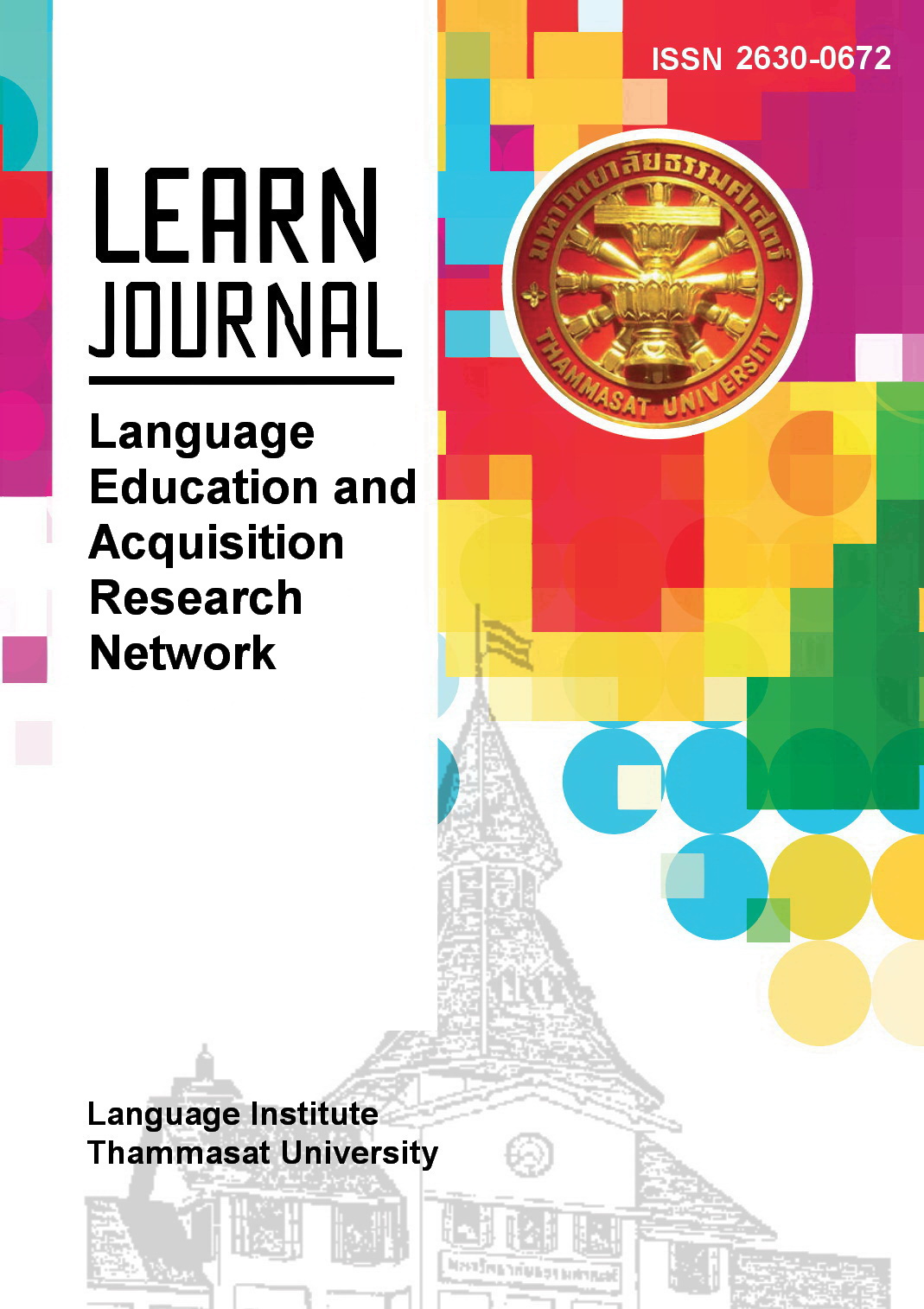Investigating Novice Translators’ Instrumental Competence in Translating from and into a Foreign Language
Main Article Content
Abstract
Instrumental competence is universally considered a compulsory competence for translators. Given its significance, this study investigated the instrumental competence of novice translators in translating from and into a foreign language. To this end, an experiment was conducted with a group of 31 Thai EFL learners who had taken English-Thai Translation and Thai-English Translation courses. Data was collected using recordings of the participants’ on-screen translation activities, their translated texts in English and Thai, a pre-translation questionnaire, a post-translation questionnaire, interviews, and direct observations. Not only did the results of the research confirm the growing popularity of electronic translation resources, particularly Machine Translation (MT), but they also revealed that the number of resources used, the total time taken for searches, the number of searches carried out, and the variety of searches carried out did not contribute to the acceptability of the solutions to translation problems. Regarding directionality, various aspects of translating into a foreign language demanded a higher use of translation resources. These results indicated that instrumental competence consists of the translator’s knowledge of translation resources and their ability to use them. Consequently, this study proposes that translation teachers and institutions develop novice translators’ instrumental skills to prepare them for the translation market where the expert use of modern-day resources and the ability to translate texts accurately, regardless of directionality, are required.
Article Details
References
Alshargabi, E., & Abdu Al-Mekhlafi, M. (2019). A survey of the Yemeni translation market needs. Journal of Social Studies, 25(1), 113-131. https://doi.org/10.20428/JSS.25.1.5
Al-Tuwayrish, R. (2016). An evaluative study of machine translation in the EFL scenario of Saudi Arabia. Advances in Language and Literary Studies, 7(1), 5-10.
Aubakirova, K.A. (2016). Nurturing and testing translation competence for text-translating. International Journal of Environmental & Science Education, 11(11), 4639-4649.
Bowker, L. (2023). De-mystifying translation. Routledge.
Chang, C. Y. (2009). Testing applicability of eye-tracking and fMRI to translation and interpreting studies: An investigation into directionality [Doctoral dissertation, University of London]. University of London Research Repository. https://spiral.imperial.ac.uk/bitstream/10044/1/
/2/Chang-CY-2009-PhD-Thesis.pdf
Colina, S., & Venuti, L. (2017). A survey of translation pedagogies. In L. Venuti (Ed.). Teaching translation: Programs, courses, pedagogies (pp. 203-215). Routledge.
Creswell, J. (2012). Education research: Planning, conducting, and evaluating quantitative and qualitative research. Pearson.
Eser, O. (2014). Setting learning objectives in translation at the department of foreign language teaching through the concept of competence. Turkish Studies, 9(5), 943-951.
Göpferich, S. (2009). Towards a model of translation competence and its acquisition: The longitudinal study TransComp [PDF file]. https://pdfs.semanticscholar.org/254d/069d13b230faf92f7e04ffab32d5473df633.pdf
Hatim, B. (2014). Teaching and researching translation. (2nd ed.). Routledge.
Hurtado Albir, A. (2015). The acquisition of translation competence. Competences, tasks, and assessment in translator training. Meta, 60(2), 256–280. https://doi:10.7202/1032857ar
Hurtado Albir, A. (2017). Translation and translation competence. In A. Hurtado Albir (Ed.), Researching translation competence by PACTE Group (pp. 3-33). John Benjamins.
Károly, A. (2011). Exploring learners’ needs and expectations: Translating EU texts in an English bachelor’s program at a Hungarian college. WoPaLP, 6, 58-85.
Kate-Phan, K., & Sripetpun, W. (2016). Attitudes, behaviors and problems of English major students in using “Google Translate”. Journal of Liberal Arts, Prince of Songkla University, Hat Yai Campus, 8 (1), 79-96.
Kazuharu, Y. (2017). A bibliometric analysis of Master’s theses relevant to Translation Studies in Thailand. International Journal of East Asian Studies, 21(2), 89-105.
Kelly, D. (2010). Curriculum. In Y. Gambier, & L.V. Doorslaer (Eds.), Handbook of translation studies (pp. 87-93). John Benjamins.
Kuznik, A. (2017). Use of instrumental resources. In A. Hurtado Albir (Ed.), Researching translation competence by PACTE Group (pp. 219-241). John Benjamins.
Kuznik, A., & Olalla-Soler, C. (2018). Results of PACTE group’s experimental research on translation competence acquisition.The acquisition of the instrumental sub-competence. Across Languages and Cultures, 19(1), 19-51. https://doi: 10.1556/084.2018.19.1.2
Neunzig, W. (2017). Methodological background. In A. Hurtado Albir (Ed.), Researching translation competence by PACTE Group (pp. 43-60). John Benjamins.
OpenAI. (2023, March 26). Better language models and their implications. Introducing Chat GPT. https://openai.com/research/better-language-models
PACTE. (2000). Acquiring translation competence: Hypotheses and methodological Problems in a research project. In A. Beeby, D. Ensinger, & M. Presas (Eds.), Investigating translation (pp.99-106). John Benjamins.
PACTE. (2003). Building a translation competence model. In F. Alves (Ed.), Triangulating translation: Perspectives in process-oriented research (pp.43-66). John Benjamins.
PACTE. (2009). Results of the validation of the PACTE translation competence model: Acceptability and decision making. Across Languages and Cultures, 10(2), 207-230.
PACTE. (2017). Developing the research design. In A. Hurtado Albir (Ed.), Researching translation competence by PACTE Group (pp. 63-80). John Benjamins.
Riabroi, P. (2016). The use of team-based learning in the development of translator competence in a translation classroom [Doctoral dissertation, Thammasat University]. TU Digital Collections. https://digital.library.tu.ac.th/tu_dc/frontend/Info/item/dc:89635
Rodríguez-Inés, P. (2010). Electronic corpora and other information and communication technology tools, The Interpreter and Translator Trainer, 4(2), 251-282. https://doi.org/10.1080/13556509.2010.10798806
Schäffner, C., & Adab, B. (2000). Developing translation competence. John Benjamins Publishing Company.
Shih, C.Y. (2017) Web search for translation: an exploratory study on six Chinese trainee translators’ behaviour, Asia Pacific Translation and Intercultural Studies, 4(1), 50-66. https://doi.org/10.1080/23306343.2017.1284641
Son, J. (2018). Back translation as a documentation tool. Translation & Interpreting, 10(2), 89-100. https://doi.org/10.12807/ ti.110202.2018.a07
Suksiripakonchai, W. (2017). Teaching translation studies and the effect on students’ translation Approaches. The New English Teacher, 11(11), 36-169.
Sycz-Opoń, J. (2019). Information-seeking behaviour of translation students at the University of Silesia during legal translation – an empirical investigation. The Interpreter and Translator Trainer, 13(1), 1-25. https://doi.org/10.1080/1750399X.2019.1565076
Toudic, D., & Krause, A. (2017). European master’s in translation competence framework 2017 [PDF file]. https://ec.europa.eu/info/sites/info/files/emt_competence_fwk_2017_en_web.pdf
Venuti, L. (2017). Translation, interpretation, and the humanities. In L.Venuti (Ed.). Teaching translation: Programs, courses, pedagogies (pp. 1-14). Routledge.
Vidhayasai, V., Keyuravong, S., & Bunsom, T. (2015). Investigating the use of Google Translate in “Terms and Conditions” in an airline’s official website: Errors and implications. PASAA, 49, 137-169.
Wongranu, P. (2017). Errors in translation made by English major students: A study on types and causes. Kasetsart Journal of Social Sciences, 38, 117-122. http://dx.doi.org/10.1016/j.kjss.2016.11.003


